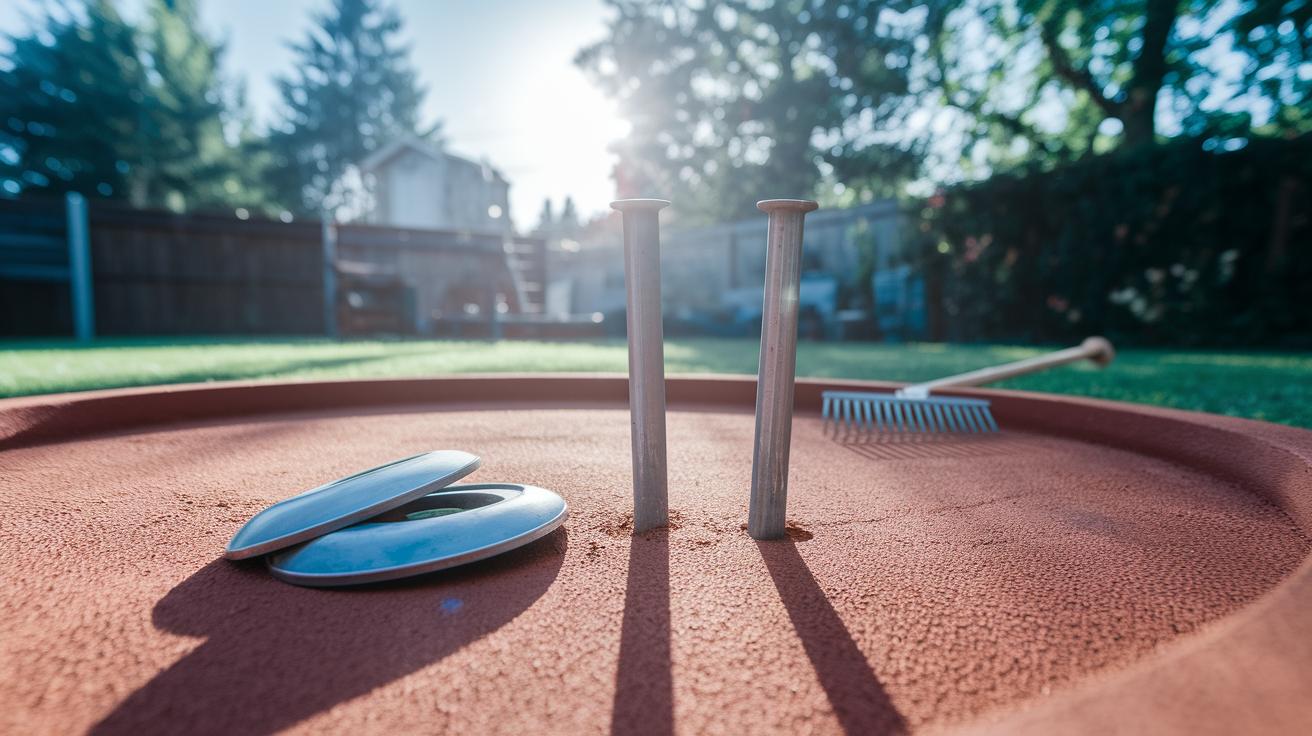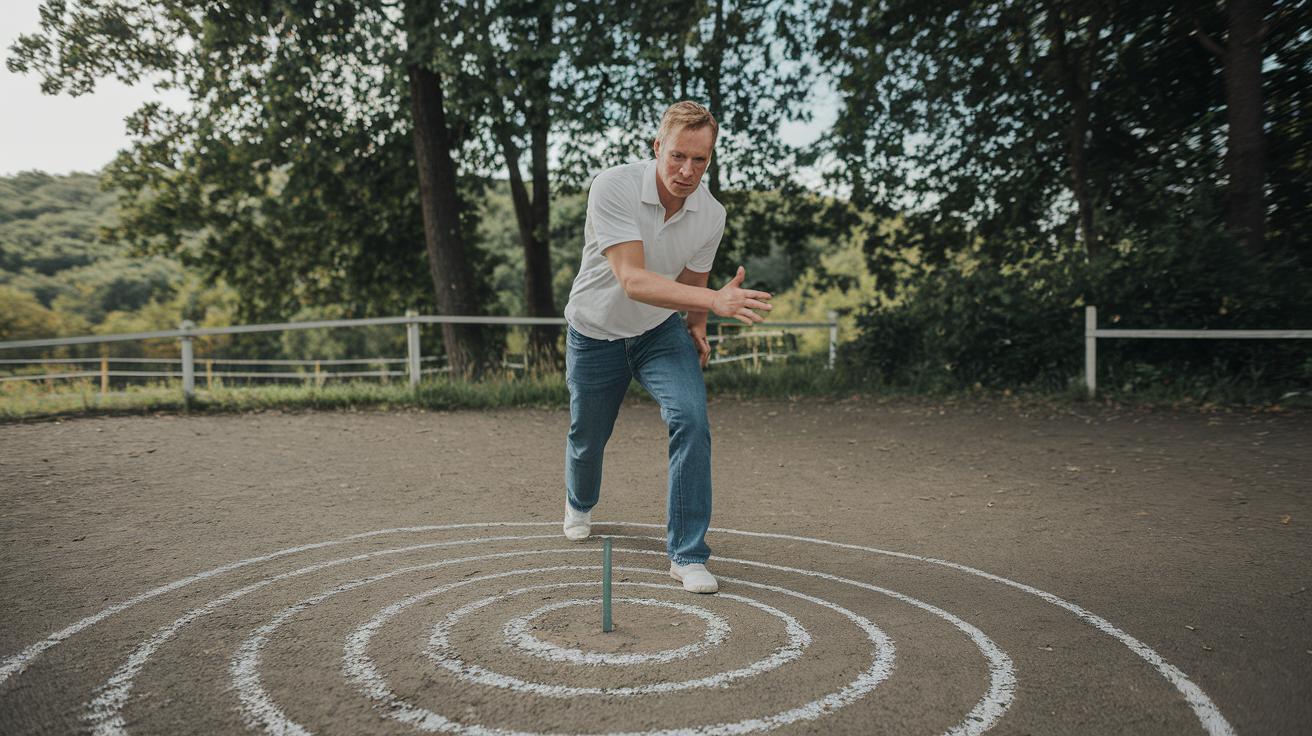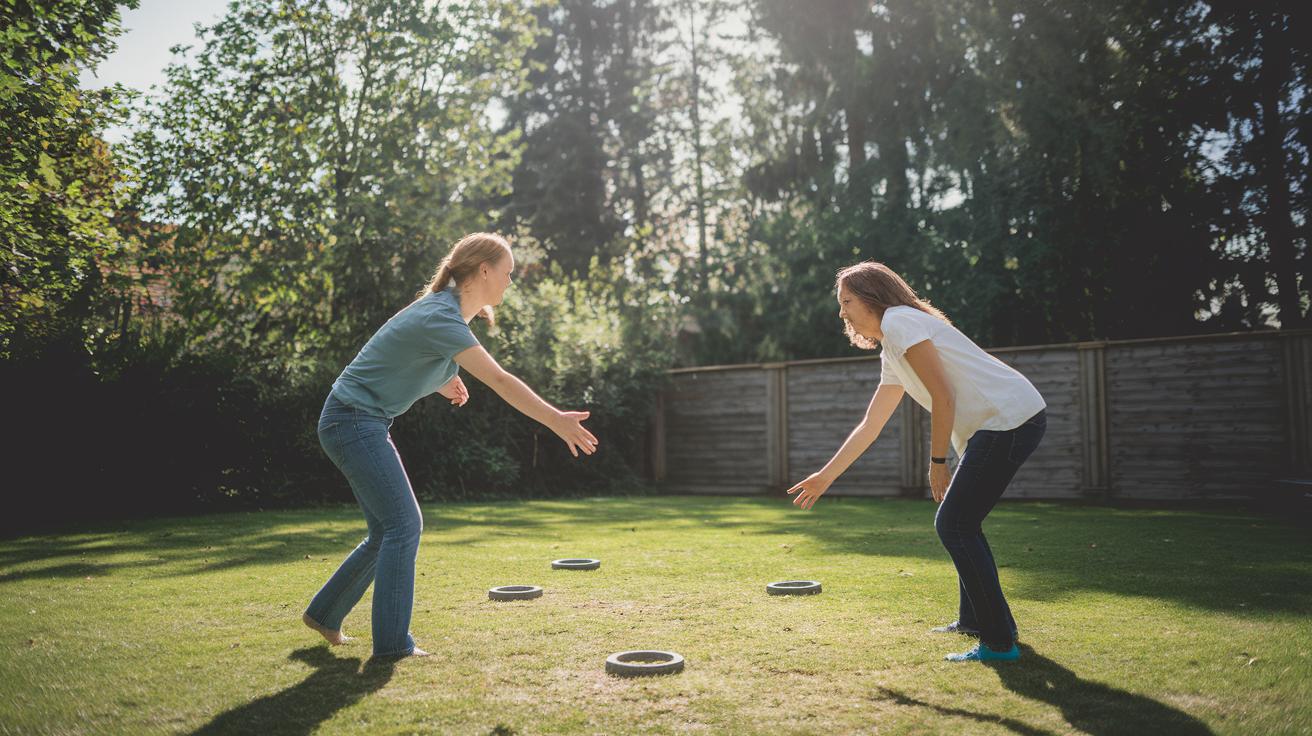How To Play Horseshoes: Amazing Guide
Ever think you need expensive gear to play horseshoes? Guess what, you only need a U-shaped metal shoe (the horseshoe) and a wooden stake (a post you hammer into the ground).
First, find a level spot in the yard and dig two holes about forty feet apart. That’s just a few big steps if you pace it out. Oops, I dropped my shovel. Classic gardener move.
Next, hammer the stakes in until they feel firm underfoot. This marks your lane (the open space between the posts). Feel the cool grass under your toes, then grip the shoe low and toss it underhand, like you’re rocking a baby. Watch it spin against the sky.
Keep track of your points: a ringer (when the shoe loops around the stake) scores three, a lean-on (when it rests against the post) scores one. Soon you’ll hear that deep thud when a shoe clings just right. Yes!
By game’s end, you’ll be banking ringers like a pro and swapping laughs with neighbors. It’s just like planting seeds and watching them grow, except you’re growing your backyard fun instead.
Let’s get tossing!
Step-by-Step Guide to Playing Horseshoes
Have you ever felt a cool horseshoe in your palm on a sunny afternoon? It’s like holding a piece of backyard history. Let’s set up two metal stakes forty feet apart (they go about fifteen inches into the ground so they stand roughly fourteen inches tall). Around each stake, mark a pitching area that’s six feet wide and ten to fifteen feet long. The foul line sits thirty-seven feet from the opposite stake. Easy so far, right?
You need four horseshoes, two per player. They each weigh about two and a half pounds. Stand behind the foul line with your feet shoulder width apart. Take a deep breath and get ready to toss underhand. Feel the grass under your shoes.
Every inning follows the same simple steps:
- Check your stakes and shoes so everything’s in place.
- Line up your feet behind the foul line.
- Toss the horseshoe underhand, keeping your arm straight and your motion smooth.
- After all four shoes land, see which one is closest to the stake (use a tape measure if you like).
- Swap turns so each player throws two shoes per inning.
- Add up the points for that inning and keep a running total.
First to reach twenty-one points wins.
And one more thing, if your shoe hits the stake, that’s a ringer worth three points. Shoes that land closest (but don’t touch) score one point each. If both players nail a ringer, they cancel out. Simple yard fun.
So grab a friend. Feel that ring of metal against metal. And let the games begin!
Essential Equipment and Court Setup for Horseshoes

Did you know a matte finish on your horseshoes can cut glare like sunglasses? That trick stops you from squinting when the sun’s low. So let’s talk gear, you know.
First, pick your shoes. Steel ones stay true longer; cast iron ones feel hefty in your hand. Look for beveled edges (angled sides) so they dig into your pit instead of bouncing off. And slip on nylon sleeves to hush clatter and save your lawn.
You’ll also want a rake for smoothing your pit surface. A tape measure for quick distance checks. And chalk or a spray marker for marking clear foul lines.
Now for court setup. Drive two stakes 40 feet apart. Push them about 15 inches into the ground so roughly 14 inches poke up. (Check your rule guide for exact measurements, trust me, I once got it backward.)
Clay pits need that soft-but-firm feel. Rake gentle arcs, then mist the surface until it holds a shoe without turning to mud. Sand pits work the same way: smooth them, then spritz water till they’re lightly damp.
And hey, if you’ve got a garage or patio, portable frames let you play anywhere. After each match, rake the edges so the pit stays uniform. And don’t forget a quick spray between games to keep every toss feeling solid. My dog even started napping by the pit once, must be the zen vibe.
Rules Overview and Scoring System in Horseshoes
Have you ever played horseshoes on a sunny afternoon? Each round you get four throws, two at each stake. It’s simple fun.
You step up behind the foul line. Swing the horseshoe underhand. Feel the cool metal spin through the air. Then let it land by the stake.
Once all four shoes settle, it’s time to score. We look for the shoe closest to the stake. If both players land the same top shot, like a perfect ring, they cancel each other out (that’s cancellation scoring).
Oops, step over the foul line and that toss doesn’t count. So keep your feet behind the line.
| Shot Type | Points | Condition |
|---|---|---|
| Ringer | 3 | Shoe fully circles stake |
| Leaner | 1 | Shoe touches stake and leans against it |
| Single Point | 1 | Closest shoe within six inches of stake |
| No Score | 0 | Shoe farther than six inches or fouled |
Keep playing rounds until someone hits twenty-one points. If you both reach twenty-one in the same round, the higher score wins.
You can pick a lower target like eleven or fifteen to keep matches quick and lively.
Mastering Pitching Technique and Proper Stance in Horseshoes

Feeling the warm earth under your shoes? Plant your feet shoulder-width apart, toes pointing right at the stake. Bend your knees just a bit, no stiff legs here. Pivot on your back foot when you need more power or a subtle aim tweak. Feels solid, right?
Now pick up that horseshoe by its open end. Wrap your fingers around both sides, or cradle one side and rest your thumb on top, whatever feels right in your hand (that’s your grip). By the way, my dog tries to steal the horseshoes every time, funny, right? Back to grip: Oops, umm I dropped mine on the first try, but hey, you’ll get it fast.
Think of your arm like a gentle pendulum (straight back, then straight forward). Keep that swing smooth so the shoe flies true toward the stake. You’re working on your hand-eye coordination here and honing that natural flow.
Release the shoe just after it sails past your hip, palm facing the target. Letting go at the same spot each time makes a big difference in distance and accuracy, you know? Stick with it and you’ll lock in that sweet spot.
Want steadier throws? Give your wrist a tiny flick right at release for a clean spin (that’s spin control). One full rotation keeps the shoe balanced in flight. Less wobble means more ringers.
And don’t stop moving after you let go. Let your arm keep pointing at the stake, that’s your follow through. It seals your direction and builds muscle memory so tossing feels effortless before you know it.
Strategies, Variations, and Advanced Tactics in Horseshoes
Have you ever heard that satisfying clink when your shoe hits just in front of the stake? That’s your chance to block an opponent’s perfect ring (when the shoe fully circles the stake). It’s a small tweak, but it can flip a close game in your favor. And when you lean your shoe so it tips against the stake, a leaner (tipping shot), you cancel out their ringer and keep the score tight.
Oops, I once missed a rebound shot off the pit’s edge (the clay-lined playing area), but when you nail it, you can knock their shoe away and steal points. Feels like a little victory dance every time.
In a singles match, you and one other player each toss two shoes at the stake. Every throw matters, no pressure, right? In doubles, partners rotate: A1 and B1 aim at one stake, then A2 and B2 at the other. You’ll find yourself cheering for your partner’s shot as much as your own.
Ready for tournament play? Official rules set stakes forty feet apart and use a regulation clay pit. Most leagues use cancellation scoring (matched ringers cancel out) and measure distance with precise tapes. Step past the foul line (the pit’s front edge) and you score zero. Suddenly every ringer feels like a heart-pounding moment.
For a fun backyard or family barbecue, try easy tweaks: move stakes in to thirty feet for quicker rounds or swap in eight-inch stakes for the kids. Youth leagues often use softer horseshoes and let little players stand closer. You can even agree on a lower point goal, first to eleven, say, so everyone stays in the game and cheers each other on.
Practice Drills to Improve Accuracy and Consistency in Horseshoes

Tossing horseshoes well means repeating throws until your body just knows what to do. It’s like learning to ride a bike. You wobble at first. Keep going, and soon you’re smooth.
And speaking of wobbles, oops I once skipped distance work and thought my 40-foot toss felt perfect, until it hit flat and stopped 10 feet short! That smack on the grass made me rethink my whole swing.
-
Distance Calibration
First, set up markers at 20, 30, and 40 feet from your stake (metal post). At each spot, throw ten shoes, noting where they land. Feel how a slight wrist flick or a stronger push changes the flight path. After a few rounds you’ll see a pattern, then tweak your arm swing until most shoes lean right into the stake. -
Target-Circle Accuracy
Next, draw circles in the pit (playing area) at six, twelve, and eighteen inches from the stake. Aim to land two shoes inside each ring before you move back. It’s like shooting free throws. Start close, then step back. When your shoe bumps that inner circle, give yourself a high five! -
Spin Consistency
Now switch between spin (rotation around the horseshoe’s axis) and no-spin throws. Do five with a full wrist roll, then five simple underhand releases. You’ll feel which style flies straighter. So adjust your grip and timing as you go.
Warm up first with easy tosses, wrist stretches, and a few pivots on your back foot. That way your muscles remember the motion and you’re ready for longer shots.
So grab your shoes and start practicing! You’ve got this.
Identifying and Avoiding Common Mistakes in Horseshoes
Playing horseshoes is fun but tricky. Even if you’re pumped, you might see your shoe clink off the stake or sail wide. Oops, those close misses really sting. Everyone trips up at first, but once you spot the usual slipups, you’ll fix them in no time.
First mistake: overthrowing. When you heave too hard, your shoe misses wide. Try a shorter swing and ease off the power. Aim to land softly near the stake every time.
Next, watch your follow-through. If your arm drops too soon, the shoe flies low. Keep your arm pointed at the stake after release and let your swing finish naturally. You’ll see the shoe soar in a nice arc.
Then there’s the foul line. Stepping over means zero points, no matter how close you get. I once had my foot inch past the line, ouch. Stay on your back foot until the shoe hits the ground. (See Section 3 for full foul-line rules.)
Leaners can be exciting, but they only count when the shoe tips against the stake and holds. Tweak your release angle so it gently nudges the stake and stays put. Think of it like coaxing it to cling.
Watch out for bounce-forwards too. If your shoe hops past the foul line, you lose points. Soften your wrist drop at release and think gentle instead of slam. You’ll land inbounds more often.
By the way, the soft thunk of a perfect toss is so satisfying, right?
Safety Precautions and Maintenance for Your Horseshoes Set

Before every toss, clear the area of friends, kids, and curious pups! Then try an underhand throw – it’s easier on your shoulder and wrist. That way, you can aim for ringers without worrying about bumps or spills.
- After each game, wipe your horseshoes (the U-shaped metal shoe we toss) with a soft cloth. Drying them off helps keep dirt and moisture from causing rust.
- Check each horseshoe and metal stake (the rod you hammer into the ground) for cracks, sharp bits, or bends. Swap out anything that looks too worn.
- Rake and smooth the clay or sand pit (play area filled with clay or sand) before you play. A flat spot keeps your feet steady and cuts down on trips.
- Rub a thin coat of oil onto each horseshoe before you store them. Slip them into a dry bag or box – an easy trick to keep rust away.
- When you’re cleaning or checking gear, wear work gloves and sturdy shoes. They’ll protect your hands and toes from heavy metal accidents.
Oops, I once tipped the oil bottle all over my shoes – messy but a good lesson!
Now you’re all set for a safe, fun game of horseshoes.
Organizing Horseshoes Tournaments and Local League Play
Ever heard that satisfying clank of a perfect throw? Organizing a horseshoes event can feel like hosting a summer party, fun, simple, and a bit nostalgic.
First things first: stick two metal stakes into the ground forty feet apart. Dig small clay pits (moist clay that grips your horseshoe) around each stake. Play until someone reaches twenty-one points. Easy.
Next, choose your event style. Single elimination brackets keep the pace fast. Round-robin pools give everyone more throws. Ladder matchups let players climb the ranks. Pick based on how much time you’ve got, how many folks are coming, and how fierce you want the competition to be.
Scorekeeping is a snap. Use a printed sheet or a phone app that logs each inning, think of innings as rounds where each player tosses twice. List names, track points, then add up totals. I’ve even seen apps that send live updates so teams know who’s up next.
You’ll need someone to watch the pits. They call fouls when a foot crosses the line. They measure throws with a tape or gauge and decide on ringers (hoops around the stake) or leaners (horseshoes leaning on the stake). Clear hand signals and a calm voice keep everyone friendly and focused.
For local league play, think weekly or monthly meetups. Move stakes closer for beginners. Fit six to eight teams into a loose schedule. Award small prizes, like soda cans or homemade treats, for top finishers. And send match times early so nobody shows up in the dark.
Ready to host your own horseshoes tourney? Grab your neighbors, feel the warm sun on your neck, and let’s get tossing.
Final Words
We jumped right into a clear, six-step inning flow. You saw how simple it is to set up your court.
Then you checked off all the gear and measurements. You got a grip on scoring, stance, and spin control. You discovered drills to sharpen your aim and found where newbies slip up. Safety pointers kept you and your gear ready. You even got ideas for hosting matches with friends.
Now you’re ready with everything you need for fun on the lawn and know how to play horseshoes with confidence and joy.
FAQ
How do you play horseshoes?
Playing horseshoes involves underhand tosses toward two stakes set 40 feet apart. Players alternate throwing two horseshoes each inning, then measure which landed closest or encircled the stake. The first to 21 points wins.
What equipment do I need to play horseshoes?
Playing horseshoes requires four horseshoes (two per player) weighing about 2.5 pounds each and two metal stakes. You’ll also need a rake for pit maintenance, a tape measure for scoring, and markers for foul lines.
What are the standard court dimensions and stake placement?
Standard court dimensions place stakes 40 feet apart, driven 15 inches into the ground and protruding 14–15 inches above. The pitching box is 6 feet wide by 10–15 feet long, with the foul line at 37 feet.
How do you score points in horseshoes?
Scoring in horseshoes awards three points for a ringer (horseshoe encircling the stake) and one point for the closest shoe within six inches. Equal ringers cancel each other. The match ends when a player reaches 21 points.
What’s the proper stance and pitching technique?
Proper stance in horseshoes means feet shoulder-width apart behind the foul line, pivoting on the back foot for balance. Hold the horseshoe by its open end, swing underhand like a pendulum, release past your hip, and follow through toward the stake.
What common mistakes should beginners avoid?
Common mistakes include stepping over the foul line (resulting in no score), inconsistent follow-through causing low arcs, and using too much force. Correct these by practicing steady foot placement, balanced swings, and measured tosses.
How do I maintain horseshoes and the playing pit?
Maintaining horseshoes involves wiping them dry after play, applying light oil to prevent rust, and storing them in a dry bag or box. Keep the pit surface level by raking clay or sand and managing moisture.
What tournament formats are common and how can I organize local play?
Organizing tournaments uses single elimination, round-robin, or ladder formats. Track innings and scores with printed sheets or digital apps, assign referees for foul enforcement and measurements, and adapt court sizes and schedules for casual or youth leagues.







